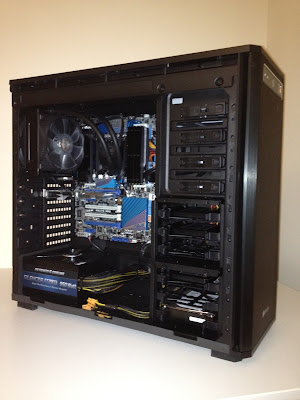Recently – after struggling with trying to setup complex
multiple virtual server labs inside VMware Workstation running on a networked
setup of 8GB RAM laptop, four year old gaming machine with 6GB RAM, and five
year old laptop with 2GB RAM – I decided it was time to invest in a new lab
machine that was suitable for building up virtual labs to simulate and learn
about complex IT infrastructures.
Here’s what I
went for:
I went over to www.overclockers.co.uk
and there is a nice Custom System Configuration there (Home >> Systems
& Bundles >> Full Systems >> System Configurator) and went for
the “Intel X79 Sandybridge – E 10300i Configurator – Workstation & Gaming
System” with:
Configurator options:
Corsair
Obsidian 550D Quiet Midi Tower Case
Intel
Core i7-3820 3.6GHz (Sandybridge-E) Socket LGA2011 Processor
Note: The above is
a quad core processor with Hyper-Threading, so 8 logical cores, which is plenty
for the lab – don’t need the extra cores provided by the more expensive but
slightly slower hex cores
No
Overclocking Option
Intel
Liquid Cooling Solution CPU Cooler
Asus
P9X79 PRO Intel X79 (Socket 2011) DDR3 Motherboard
Note: The motherboard
supports 64GB RAM, and has 4 x 6Gb/s internal SATA III ports, and 4 x 3Gb/s internal SATA II ports
Corsair
Dominator 32GB (4x8GB) 1600MHz C10 Quad Channel Kit
MSI
HD 5450 1024MB GDDR5 Graphics Card
Seagate
Barracuda 2TB 7200RPM SATA 6Gbps 64MB Cache
Note: This is just
for data
No
RAID Option
PC
Power & Cooling Silencer MK II 950W 80 Plus Silver Power Supply
No
Operating System
No
Case Mods Required
Additional purchases
(not available in the configurator):
Corsair
Dominator 32GB (4x8GB) 1600MHz C10 Quad Channel Kit
OCZ
Vertex 4 256GB 2.5” SATA 6Gb/s SSD (VTX4-25SAT3-256G)
OCZ
Vertex 4 512GB 2.5” SATA 6Gb/s SSD (VTX4-25SAT3-512G)
Note 1: I could
have gone for the slightly less performant VTX4-25SAT3-512G.M which uses Micron
NAND as opposed to Toshiba NAND, and saved £100 a pop, but – hell – this
machines going to last a long time, and don’t want to compromise on SSD
performance, even if I’d probably never notice the difference
Note 2: The 256GB
SSD is for the O/S and programs (Windows 7 Ultimate (x64) and Windows Server
2012 (with Hyper-V R3) dual boot), the 512GB SSDs are purely for virtual
machines
Note 3: The OCZ
Vertex 4 2.5” SSDs come with a 3.5” caddy
Total Cost:
Just under £2500
Now, this is a lot
of money, but when considered over the intended lifetime of 5 years, that’s pretty
much the price of a box of Jaffa Cakes a day! And with the time savings recovered
from provisioning labs, and the career benefits of being able to make better and
bigger labs than ever before – it is a sensible purchase!?
Delivery:
Arrived on the Saturday as requested, less than 5 days
from placing the original order, and well built, just left for me to put in the
additional 32GB RAM, 3 x SSD drives, and apply an operating system.
Images:
Fig. 1: The System –
just about visible are the 8 DIMMs – 4 either side of the CPU, and the 3 SSDs
in bays 1,2,4 with the SATA drive in bay 6
Fig. 2: Task
Manager – 65513 Total Physical Memory (MB)
Fig. 3: Device
Manager – 4 x Disk drives, and 8 x 3.6GHz Processors
Final Note
On a final note, I did encounter one glitch. When copying
about 10GB’s worth of files onto one of the SSDs from a USB 3.0 drive, the
copy process hung and I had an:
Event ID: 129
Source: iaStorA
Reset to device,
\Device\RaidPort1
I killed the copy process – basically explorer.exe – via task
manager and re-ran explorer.exe but this failed to recover access to drives – I
couldn’t see any drives! The VDS service crashed/terminated unexpectedly too –
this might have been me killing explorer.exe. A hard reset was the only way to
recover the system as it would not shutdown to reboot.
The fix appears to have been updating the BIOS – from 1103
(or something like that) to 3009. To be honest it was a bit sloppy of me not to
update the BIOS from the off. Another thing is to check none of the SATA drives
are enabled for hot-swap in BIOS as it appears I had inadvertently done this
whilst initially configuring my system (I have no need for hot-swap.) And from
then it has run fantasticallyJ!



this is a beautifully timed post, as I am looking at pretty much the same spec for the same purpose...
ReplyDeleteJust getting signoff now. Thanks again
ps - is this the RAM you purchased?
https://www.overclockers.co.uk/showproduct.php?prodid=MY-318-CS
Hello Carl,
DeleteYes, that is indeed the RAM I purchased.
Cheers!
VCosonok
Hi Carl,
ReplyDeleteThank you for this post! This is exactly what I want to build for my lab setup.
Couple of questions.
1. Have you tried installing VMWare ESX 5.1 on this box?
If yes, was it a success or did you encounter any installation problems?
2. Have you tried installing Windows Server 2012 on this box?
If yes, was it a success or did you encounter any installation problems?
Thanks,
John
Thanks for the post - I had just independantly done a specification for pretty much the same purpose as you _ ( plus a few games :-)) but nice to see that the MOBO / CPU / SSD / RAM combination will be sufficient to run a lab or three.
ReplyDelete